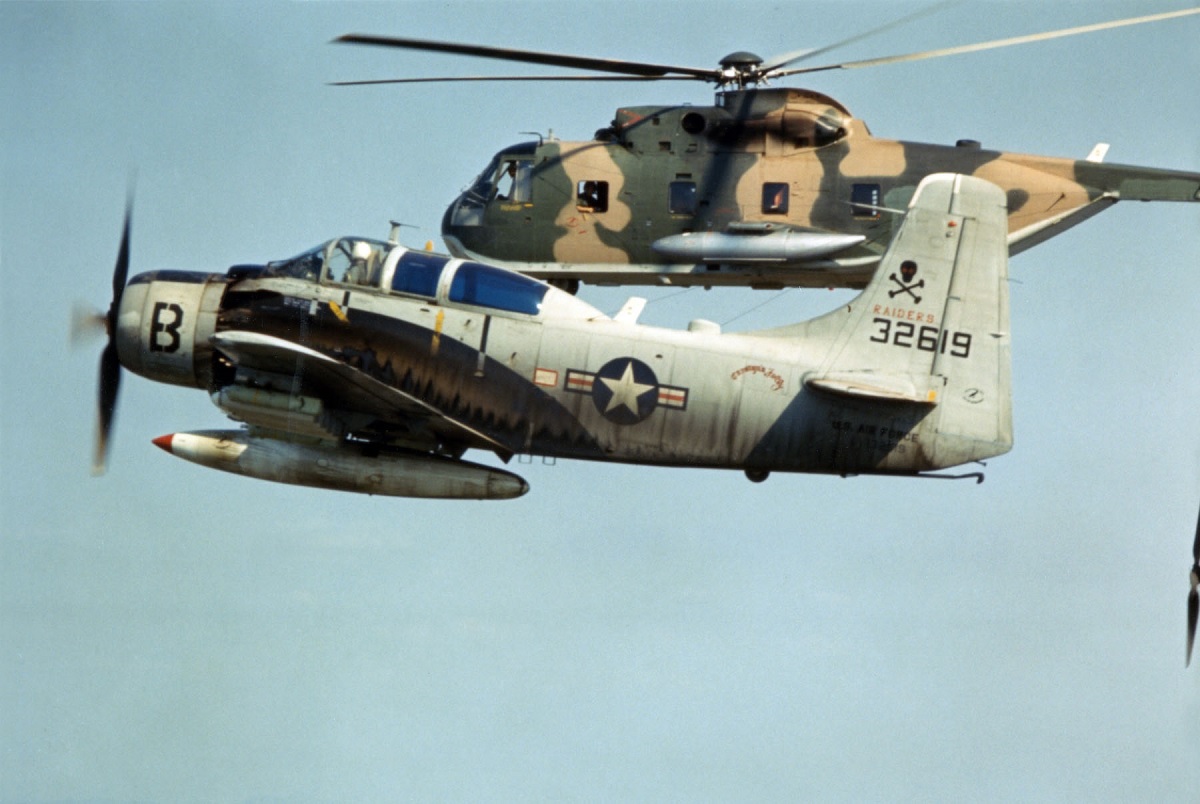Many pilots who were shot down remembered how the sound of a Sandy passing overhead gave them hope when everything looked desperate
Combat Search and Rescue (CSAR) personnel made a crucial contribution throughout the Vietnam War and upheld their motto, “That Others May Live.” They helped 4,120 people in total, and 2,780 of them were in combat. They received 38 Air Force Crosses, two Medals of Honor, and countless other honors for their outstanding accomplishments. However, the price was tremendous as 45 planes were lost and 71 American rescuers perished during the conflict.
As Peter E. Davies explains in his book Ho Chi Minh Trail 1964–1973, SAR efforts could turn into large-scale operations requiring multiple planes over a number of days.
On January 17, 1969, the crew of a Stormy FAC aircraft that included an F-4D Phantom II (66-8773) attacked a 37mm AAA site while on an armed reconnaissance mission over southern Laos. One F-4D was struck and crashed in flames. The WSO in the back seat was able to eject, which led to a rescue operation involving 284 aircraft. One Sandy A-1H (52-134632) from the initial flight was shot down, and the HH-53B “Jolly Green 67” rushed to save its pilot, Lt Col Lurrie Morris, the commander of the 602nd SOS, and look for the F-4D crew.
It crashed near Tchepone and was severely damaged. While strike aircraft destroyed “Jolly Green 67” to prevent its capture, a second HH-53B, “Jolly Green 70,” came in to rescue its crew and Morris. The next day, a second Sandy (52-134588) and its pilot, Capt. Robert Coady were destroyed by heavy 37mm fire as the hunt for the missing F-4 pilot went on. While Sandys used tear gas to keep the enemy at bay, an O-2A that was in the same area inspecting the damage to trucks from the previous night was struck. The rescue team diverted to pick up its crew.

The recovery of a 12th TFW F-4C crew, “Boxer 22,” required one of the largest SAR operations, which took place close to Ban Phanop in southern Laos, one of the Ho Chi Minh Trail’s most heavily defended areas. A 37mm hit caused the crew to eject, and on December 5, 1969, a 51-hour rescue operation comprising 366 sorties (including 171 by A-1 Sandys) got underway. Seven Nakhon Phanom helicopters tried a recovery on the first day, but one of them ended up with its tail boom caught in a tree. All of them were chased away by ground fire, and 47 A-1 sorties were flown nonstop to put out gunfire coming from roughly a hundred different sources.
Capt Ben Danielson, the F-4C pilot, was killed by NVA soldiers, but 1Lt Woodie Bergeron, the backseater, was finally rescued by an HH-53 from behind a dense smokescreen after spending two nights on the ground or submerged in a river covered in forest. Five A-1s and 12 other aircraft suffered heavy damage, and a para jumper died. 24 A-1 Sandy aircraft made a mass return to Nakhon Phanom, and 4,000 people gathered at the base to welcome the HH-53 carrying Bergeron. It was a graphic demonstration of the US objective of protecting its own men at great cost.
Airmen likely benefited from this knowledge as they launched incredibly perilous flights over Laos and Vietnam. Many pilots who were shot down remembered how the sound of a Sandy passing overhead gave them hope when everything looked desperate.
On April 2, 1972, the EB-66C 54-0466 “Bat 21,” which was providing ECM protection for an Arc Light strike, was shot down by an SA-2 near the DMZ. This incident serves as another outstanding example of the tenacity of SAR operators. Lt Col Iceal “Gene” Hambleton, a 53-year-old navigator, was the only crew member to eject, and he landed near to an NVA troop concentration. The ensuing 11 days saw the mounting of the largest SAR operation of the conflict (as dramatized in the film Bat 21, with Gene Hackman playing Hambleton). Another SA-2 destroyed an HC-130 “King Bird” that was flying over the area, but Lt Col Bill Jankowski, an O-2A FAC headquartered in Da Nang, made touch with Hambleton as he was parachuting down. Later, Capt Gary Ferentchak in a Pave Nail OV-10A confirmed his location.
As they approached, Sandy A-1s strafe NVA soldiers who were less than 300 feet from Hambleton’s post. Two of the four US Army helicopters that attempted the rescue were shot down. The following day, a number of FACs were still stationed there, with one of them (OV-10A Nail 38) being taken down by an SA-2.
90 strike sorties a day were flown over the next 11 days to defend Hambleton, and another OV-10A, “Covey 282,” was lost. A 37th ARRS HH-53C was struck by machine gun fire on April 6 during a final attempt at rescue, and all of its occupants perished when the aircraft crashed. Eventually, Hambleton made it to a riverbank where he was found and saved by a special operations SEAL team that had also rescued Nail pilot 1Lt Mark Clark. Lt. Tom Norris, the leader of the SEAL team, received the Medal of Honor for his rescue work.

Ho Chi Minh Trail 1964-73 is published by Osprey Publishing and is available to order here.
Photo by U.S. Air Force and TriStar Pictures

